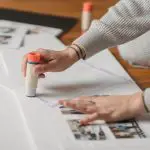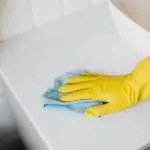Wondering if Gorilla Glue can bond fabric and metal? You've come to the right place.
This concise guide will provide you with the knowledge and techniques needed to achieve successful adhesion between these two materials.
From understanding Gorilla Glue's adhesion properties to preparation steps and application techniques, you'll gain mastery in this area.
We'll also cover factors affecting bonding strength and tips for ensuring durability.
Whether you're tackling a DIY project or a professional task, this introduction sets the stage for a comprehensive exploration of bonding fabric and metal with Gorilla Glue.
Key Takeaways
- Gorilla Glue is compatible with a wide range of materials, including fabric and metal.
- Proper preparation of fabric and metal surfaces is essential for maximizing the adhesive bond strength.
- When bonding fabric to metal, clean the fabric surfaces and check adhesive compatibility before applying Gorilla Glue.
- Factors such as cleanliness, temperature, humidity, and proper clamping or weighting during the curing process can affect the bonding strength.
Understanding Gorilla Glue's Adhesion Properties
You can understand Gorilla Glue's adhesion properties by examining its ability to bond fabric and metal with strength and durability. Gorilla Glue is known for its compatibility with a wide range of materials, including fabric and metal. When testing its bonding strength, Gorilla Glue has consistently demonstrated remarkable resilience and durability, making it a dependable choice for various bonding needs.
In bonding fabric, Gorilla Glue proves to be effective in creating a strong and lasting bond. Its ability to penetrate the fibers and create a secure connection makes it suitable for a variety of fabric-based projects. Whether it's repairing upholstery or creating fabric-based crafts, Gorilla Glue provides a reliable adhesion that withstands the test of time.
Similarly, when bonding metal, Gorilla Glue showcases its impressive strength. Through rigorous bonding strength testing, it has been proven to create a robust and enduring bond with metal surfaces. This makes it a valuable adhesive for metal-related applications, offering a dependable solution for repairs and construction projects involving metal components.
Preparation Steps for Fabric and Metal Surfaces
To ensure effective bonding with Gorilla Glue, preparing fabric and metal surfaces involves cleaning and roughening them for optimal adhesion. Surface cleaning is crucial to remove any dirt, dust, or residues that could hinder the adhesive compatibility.
For fabric, start by washing and drying it to remove any oils, dirt, or fabric softeners. Avoid using any fabric softeners or dryer sheets as they can leave a residue that interferes with the adhesive.
For metal surfaces, use a degreaser to remove any oils or grease. Next, lightly sand the metal surface to create a rough texture, which provides a better surface for the glue to adhere to.
Ensure that both fabric and metal surfaces are completely dry before applying the Gorilla Glue. Following these preparation steps will help maximize the adhesive bond strength and durability.
Properly preparing the fabric and metal surfaces is essential for achieving the best results when using Gorilla Glue for bonding.
Application Techniques for Bonding Fabric to Metal
When bonding fabric to metal, it's important to prepare the fabric surface by cleaning and roughening it to ensure better adhesion. Consider the specific properties of the metal, such as its smoothness and whether it's porous, to determine the best bonding approach.
Apply the adhesive using the appropriate method for the materials involved, whether it's a thin, even layer or a specific pattern based on the bonding considerations.
Fabric Surface Preparation
Before bonding fabric to metal using Gorilla Glue, ensure that the fabric is thoroughly cleaned and free of any dirt or debris. To properly prepare the fabric surface for bonding, follow these steps:
- Clean the fabric surface with a mild detergent and water to remove any dirt, oil, or residue.
- Allow the fabric to dry completely before applying the Gorilla Glue to ensure optimal adhesion.
- Check the adhesive compatibility of the fabric with Gorilla Glue to ensure a strong and durable bond.
- Apply the Gorilla Glue evenly onto the prepared fabric surface, and then firmly press it onto the metal, ensuring a secure bond.
Following these fabric surface preparation techniques will help you achieve a successful bond between fabric and metal using Gorilla Glue.
Metal Bonding Considerations
When bonding fabric to metal using Gorilla Glue, you should consider the application techniques to ensure a strong and lasting bond.
First, prepare the metal surface by cleaning it thoroughly to remove any dirt, oil, or residue that could hinder the adhesive strength.
Next, roughen the metal surface with sandpaper to create a textured area for the glue to adhere to.
It's important to apply the Gorilla Glue evenly and sparingly on the metal surface, ensuring that it covers the entire area where the fabric will be bonded.
Press the fabric firmly onto the metal surface, removing any excess glue that squeezes out.
Allow sufficient time for the bond to cure properly.
Following these application techniques will help maximize the adhesive strength when bonding fabric to metal using Gorilla Glue.
Adhesive Application Methods
To achieve a successful bond between fabric and metal using Gorilla Glue, you'll apply the adhesive using even and sparing techniques, ensuring full coverage and pressing the fabric firmly onto the prepared metal surface.
When applying Gorilla Glue to bond fabric to metal, it's crucial to consider adhesive compatibility. Ensure that the adhesive is suitable for both fabric and metal materials to guarantee a strong and lasting bond.
Additionally, proper surface treatment is essential for successful adhesion. Prepare the metal surface by cleaning it thoroughly to remove any dirt, oil, or debris that could hinder the bonding process. Roughen the metal surface slightly to promote better adhesion, ensuring a secure and durable bond.
Remember to follow the adhesive manufacturer's guidelines for the best results.
Factors Affecting the Bonding Strength
You can improve the bonding strength of Gorilla Glue on fabric and metal by ensuring proper surface preparation and using the recommended application techniques. Several factors can influence the adhesion properties of Gorilla Glue on fabric and metal.
The cleanliness and dryness of the surfaces are crucial for a strong bond. Any dirt, dust, or grease on the surfaces can hinder the adhesive's ability to bond effectively. Prior to applying the glue, make sure to clean the surfaces thoroughly.
Additionally, the fit and alignment of the materials play a significant role in the bonding strength. Proper clamping or weighting of the materials during the curing process can enhance the bond.
Furthermore, temperature and humidity can impact the adhesive properties. Ideal bonding conditions typically include moderate temperatures and low humidity levels.
Gorilla Glue's instructions provide specific recommendations regarding these factors, and following them diligently can significantly improve the bonding strength on fabric and metal.
Testing the Durability of Fabric-to-Metal Bonds
Testing the durability of fabric-to-metal bonds requires meticulous evaluation of the adhesive's resilience under various stress conditions. When conducting durability testing, there are key factors to consider to ensure the fabric-to-metal bond's strength and longevity:
- Adhesion Properties: Assess the adhesive's ability to bond fabric to metal under different environmental and mechanical conditions.
- Compatibility Considerations: Evaluate the compatibility of the adhesive with the specific types of fabric and metal to be bonded.
- Surface Preparation: Properly prepare the metal and fabric surfaces to ensure optimal adhesion and durability.
- Curing Process: Monitor and analyze the curing process to determine its impact on the durability of the fabric-to-metal bond.
Successful results in fabric-to-metal bonding depend on meticulous attention to material compatibility, surface preparation, and the curing process. Additionally, understanding the application techniques and bonding strength factors is crucial for achieving durable fabric-to-metal bonds.
Tips for Achieving Successful Results
To achieve successful results when bonding fabric and metal with Gorilla Glue, there are a few important factors to consider. First, it is crucial to check the material compatibility and ensure that Gorilla Glue is suitable for both fabric and metal. Once you have confirmed compatibility, the next step is to apply the glue properly. Follow the recommended curing process provided by Gorilla Glue to ensure a strong and durable bond. Taking these steps will help you achieve the desired results when bonding fabric and metal with Gorilla Glue.
Material Compatibility Considerations
Consider the specific properties of the fabric and metal to ensure successful bonding with Gorilla Glue. Material compatibility and adhesive strength are crucial factors to achieve a strong and durable bond.
Surface preparation plays a vital role in promoting adhesion, so ensure that the fabric and metal surfaces are clean, dry, and free of any contaminants. Proper surface roughening can enhance the bond strength, especially for smooth or non-porous materials.
Additionally, selecting the right bonding techniques, such as clamping or using tape to hold the materials in place during the curing process, can significantly impact the quality of the bond.
Taking these considerations into account will help maximize the effectiveness of Gorilla Glue when bonding fabric and metal.
Application and Curing Process
For best results, you should thoroughly clean and dry the fabric and metal surfaces before applying Gorilla Glue to ensure successful bonding. This will help remove any dirt, oil, or residue that could interfere with the adhesive's ability to bond effectively. After cleaning, apply a small amount of Gorilla Glue to one surface and press the two materials together firmly. Here are some tips to ensure successful bonding:
| Tips for Successful Bonding |
|---|
| Clean and dry surfaces thoroughly |
| Apply a small amount of Gorilla Glue to one surface |
| Press materials together firmly |
| Allow for proper curing time and temperature |
| Test the strength and durability of the bond |
Ensure that the curing time and temperature are appropriate for the materials being bonded to achieve optimal bonding strength and durability.
Frequently Asked Questions
Can Gorilla Glue Bond Fabric to Metal in Extreme Temperature Conditions?
In extreme temperature conditions, Gorilla Glue can bond fabric to metal. Its compatibility and durability ensure long-term performance. The bond withstands harsh conditions, providing reliable results for fabric and metal bonding.
What Is the Recommended Shelf Life of Gorilla Glue for Bonding Fabric and Metal?
For bonding fabric and metal, the recommended shelf life of Gorilla Glue is typically one year if stored properly. It can bond in extreme temperatures, but it's best to avoid extreme conditions for optimal results.
Can Gorilla Glue Be Used for Outdoor Fabric-To-Metal Bonding?
Yes, Gorilla Glue can be used for outdoor fabric-to-metal bonding. Its outdoor durability and adhesive strength make it a reliable choice for this application. Just ensure proper surface preparation for optimal adhesion.
Is It Safe to Use Gorilla Glue for Bonding Fabric to Metal on Items That Will Come Into Contact With Water or Moisture?
Yes, Gorilla Glue is water-resistant and can effectively bond fabric to metal, providing durability for items exposed to water or moisture. It's a suitable choice for ensuring a strong and lasting bond in such conditions.
How Long Does It Take for Gorilla Glue to Fully Cure When Bonding Fabric to Metal?
When bonding fabric to metal with Gorilla Glue, the curing process varies depending on the specific product used. However, once fully cured, the bond strength and fabric durability will provide reliable adhesion to the metal surface.
- How Does Ring Spun Cotton Affect Garment Fit and Shape Retention? - August 13, 2024
- What Are the Challenges in Producing Ring Spun Cotton? - August 13, 2024
- Is Ring Spun Cotton Suitable for Plus-Size Clothing? - August 13, 2024







